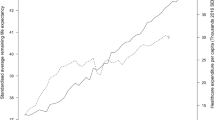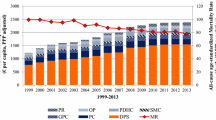Abstract
Background
The marginal productivity of a country’s healthcare system refers to the health gains produced per unit change in the level of spending. In budget-constrained settings, this metric reflects the opportunity cost, in terms of health gains forgone, of committing additional or existing resources to alternative uses within the healthcare system. It can therefore assist in evidence-based decisions on whether different interventions represent good value for money.
Objective
The aim of this paper was to estimate the marginal productivity of the Indonesian healthcare system using subnational data, and to use this to inform health opportunity costs in the country.
Methods
We define a dynamic health production function to model the stream of effects of current and prior public health spending decisions on population under-five mortality. To estimate the model, we use data from the 33 Indonesian provinces for the 2004–2012 period. The estimated elasticity is then translated into gains in terms of cost per DALY (disability-adjusted life-year) averted. We use dynamic panel data methods to address potential endogeneity issues in the model.
Results
Our base-case estimates suggest that a 1% expansion in the level of health spending reduces under-five mortality by 0.38% (95% CI 0.00–0.76), which translates into a cost of averting one DALY of $235 (2019 US$).
Conclusion
With Indonesia aiming for universal health coverage, our results support these efforts by highlighting the associated benefits resulting from increases in public health expenditure and have the potential to inform the decision-making process about a suitable locally relevant cost-effectiveness threshold.
Similar content being viewed by others
Notes
Given the changing nature of administrative units in Indonesia (with forming districts and provinces over the study period), we took efforts to adequately link districts to provinces in a given year, using information from a repository of administrative units in Indonesia from several sources (from the INDO-DAPOER as well as the Statoids website [45]).
First, wherever there was a maximum of two consecutive missing periods, we imputed the missing data by fitting smooth polynomials on the logarithm of the district level expenditure time series. Where three or more district-level data points were missing, we imputed them using the mean expenditure of the province in the given year. For province-level missing budgets and other province-level variables for a given period, we used linear interpolation (7.6% of the observations of the health expenditure variable were missing, and on average 5.9% of observations for the other variables, and never for more than one period).
The 2011 Health Facility Census (Rifaskes) reported availability issues of BCG, measles, polio and DPT vaccines in the provinces including Papua and Maluku.
The elasticity can be derived using a simple transformation and it informs of the percentage change in mortality following a 1% increase in the level of expenditure.
To ensure the conditions for instrument validity are met while avoiding the risk of instrument proliferation, we use only the first three lagged values and the log of own-source revenue as instrumental variables.
Using morbidity burden of disease allows us to capture both morbidity related to mortality (i.e., from children who would have died) and morbidity from surviving children.
We assume that this ratio stays constant with the levels of mortality.
The long-term effect of expenditure could be derived as \({\sum }_{s=0}^{k}{{{\lambda }^{s}\beta }_{0}x}_{i,\mathrm{t}-k}\). However, the coefficients of lagged mortality rates, used for this calculation, are not statistically significant at conventional levels. Our results therefore are not informative of the cumulative effect spending decisions on the current mortality rate.
Filmer and Pritchett [5] argue that the lower elasticity of IMR with respect to health spending compared to U5MR could be explained by the genetic component of neonatal deaths, which account for a large proportion of IMR.
References
World Health Organization. The World Health Report 2010: Health Systems Financing: the Path to Universal Coverage. Geneva: World Health Organization; 2010.
Moreno-Serra R, Smith PC. Broader health coverage is good for the nation’s health: evidence from country level panel data. J R Stat Soc Ser A Stat Soc. 2015;178:101–24.
Gravelle HS, Backhouse M. International cross-section analysis of the determination of mortality. Soc Sci Med. 1987;25:427–41.
Kim K, Moody PM. More resources better health? A cross-national perspective. Soc Sci & Med [Internet]. 1992;34:837–42. https://econpapers.repec.org/RePEc:eee:socmed:v:34:y:1992:i:8:p:837-842
Filmer D, Pritchett L. The impact of public spending on health: does money matter? Soc Sci Med. 1999;49:1309–23.
Bokhari FA, Gai Y, Gottret P. Government health expenditures and health outcomes. Health Econ. 2007;16:257–73.
Haile F, Niño-Zarazúa M. Does social spending improve welfare in low-income and middle-income countries? J Int Dev. 2018;30:367–98.
Gallet CA, Doucouliagos H. The impact of healthcare spending on health outcomes: a meta-regression analysis. Soc Sci Med. 2017;179:9–17.
Barenberg AJ, Basu D, Soylu C. The effect of public health expenditure on infant mortality: evidence from a panel of Indian States, 1983–1984 to 2011–2012. J Dev Stud. 2017;53:1765–84.
Edney LC, Lomas J, Karnon J, Vallejo-Torres L, Stadhouders N, Siverskog J, et al. Empirical estimates of the marginal cost of health produced by a healthcare system: methodological considerations from country-level estimates. Pharmacoeconomics [Internet]. 2022;40:31–43. https://doi.org/10.1007/s40273-021-01087-6.
Bhalotra S. Spending to save? State health expenditure and infant mortality in India. Health Econ. 2007;16:911–28.
Soares MO, Sculpher MJ, Claxton K. Health opportunity costs: assessing the implications of uncertainty using elicitation methods with experts. Med Decis Mak. 2020;40:448–59.
Culyer AJ. Cost-effectiveness thresholds in health care: a bookshelf guide to their meaning and use. Health Econ Policy Law. 2016;11:415–32.
Claxton K, Martin S, Soares M, Rice N, Spackman E, Hinde S, et al. Methods for the estimation of the National Institute for Health and care excellence cost-effectiveness threshold. Health Technol Assess (Rockv). 2015;19:1–503.
Vallejo-Torres L, García-Lorenzo B, Serrano-Aguilar P. Estimating a cost-effectiveness threshold for the Spanish NHS. Heal Econ (United Kingdom). 2018;27:746–61.
Edney LC, Haji AAH, Cheng TC, Karnon J. Mortality reductions from marginal increases in public spending on health. Health Policy (New York) [Internet]. 2018;122:892–9. https://doi.org/10.1016/j.healthpol.2018.04.011.
Van Baal P, Perry-Duxbury M, Bakx P, Versteegh M, van Doorslaer E, Brouwer W. A cost-effectiveness threshold based on the marginal returns of cardiovascular hospital spending. Heal Econ (United Kingdom). 2019;28:87–100.
Edoka IP, Stacey NK. Estimating a cost-effectiveness threshold for health care decision-making in South Africa. Health Policy Plan. 2020;35:546–55.
Mahendradhata Y, Trisnantoro L, Listyadewi S, Soewondo P, Marthias T, Harimurti P, et al. The Republic of Indonesia health system review. In: Hort K, Patcharanarumol W, editors., et al., Health systems in transition. Geneva: World Health Organization; 2017.
Pisani E, Kok MO, Nugroho K. Indonesia’s road to universal health coverage: a political journey. Health Policy Plan. 2017;32:267–76.
Statistics Indonesia—Badan Pusat Statistik (BPS) and Macro International. Indonesia Demographic and Health Survey 2007. Calverton, Maryland, USA, BPS and Macro International; 2008.
Statistics Indonesia—Badan Pusat Statistik (BPS). Indonesia Demographic and Health Survey 2012. Jakarta, Indonesia: BPS, BKKBN, Kemenkes, and ICF International; 2013.
The World Bank. Indonesia Database for Policy and Economic Research (INDO-DAPOER). 2012.
Statistics Indonesia (Badan Pusat Statistik—BPS). Indonesia—National Socio-Economic Survey 2013. Jakarta; 2014.
UN Inter-agency Group for Child Mortality Estimation (UN IGME). Levels and trends in child mortality: report 2019, Estimates developed by the United Nations Inter-agency Group for Child Mortality Estimation. New York: United Nations Children’s Fund; 2019.
Pullum TW, Staveteig S. An assessment of the quality and consistency of age and date reporting in DHS Surveys, 2000-2015. DHS Methodol Rep No 19 [Internet]. 2017;2000–15. http://dhsprogram.com/pubs/pdf/MR19/MR19.pdf
Elkasabi M. Calculating fertility and childhood mortality rates from survey data using the DHS.rates R package. PLoS One. 2019;14:1–22.
Masset E. SYNCMRATES: Stata module to compute child mortality rates using synthetic cohort probabilities [Internet]. Boston College Department of Economics; 2016. https://ideas.repec.org/c/boc/bocode/s458149.html
Hatt L, Cico A, Chee G, Ergo A, Fuad A, Gigli S, et al. Rapid analytical review and assessment of health systems opportunities and gaps in Indonesia. Bethesda: Health Finance and Governance Project, Abt Associates Inc.; 2015.
Wagstaff A. Socioeconomic inequalities in child mortality: comparisons across nine develo** countries. Bull World Health Organ. 2000;78:19–29.
Fischer Walker CL, Rudan I, Liu L, Nair H, Theodoratou E, Bhutta ZA, et al. Global burden of childhood pneumonia and diarrhoea. Lancet. 2013;381:1405–16.
Gani A. Health care financing and health outcomes in Pacific Island countries. Health Policy Plan. 2009;24:72–81.
Tandon A, Pambudi E, Harimurti P, Masaki E, Subandoro A, Marzoeki P, et al. Indonesia. Health Financing System Assessment Spend More, Right and Better. Jakarta: World Bank; 2016.
Nickell SJ. Biases in dynamic models with fixed effects. Econometrica. 1981;49:1417–26.
Arellano M, Bond S. Some tests of specification for panel data: Monte Carlo evidence and an application to employment equaltions. Rev Econ Stud. 1991;58:277–97.
Blundell R, Bond S. Initial conditions and moment restrictions in dynamic panel data models. J Econom. 1998;87:115–43.
Windmeijer F. A finite sample correction for the variance of linear efficient two-step GMM estimators. J Econom [Internet]. 2005;126:25–51. https://econpapers.repec.org/RePEc:eee:econom:v:126:y:2005:i:1:p:25-51
Acemoglu D, Finkelstein A, Notowidigdo MJ. Income and health spending: evidence from oil price shocks. Rev Econ Stat. 2013;95:1079–95.
Global Burden of Disease Collaborative Network. Global Burden of Disease Study 2019 (GBD 2019) Results [Internet]. Seattle, United States Inst. Heal. Metrics Eval. 2020. http://ghdx.healthdata.org/gbd-results-tool. Accessed 29 Jan 2021.
Ochalek J, Lomas J, Claxton K. Estimating health opportunity costs in low-income and middle-income countries: a novel approach and evidence from cross-country data. BMJ Glob Health. 2018;3:e000964.
Paulden M, O’Mahony J, McCabe C. Determinants of change in the cost-effectiveness threshold. Med Decis Mak [Internet]. 2016;37:264–76. https://doi.org/10.1177/0272989X16662242.
Lomas J, Claxton K, Ochalek J. Accounting for country- and time-specific values in the economic evaluation of health-related projects relevant to low- and middle-income countries. 2022;45–54.
Ochalek J, Wang H, Gu Y, Lomas J, Cutler H, ** C. Informing a cost-effectiveness threshold for health technology assessment in China: a marginal productivity approach. Pharmacoeconomics [Internet]. 2020;38:1319–31. https://doi.org/10.1007/s40273-020-00954-y.
Woods B, Revill P, Sculpher M, Claxton K. Country-level cost-effectiveness thresholds: initial estimates and the need for further research. Value Health [Internet]. 2016;19:929–35. https://doi.org/10.1016/j.jval.2016.02.017.
Statoids. Administrative Divisions of Countries [Internet]. 2017. http://www.statoids.com/uid.html. Accessed 25 May 2020.
CEIC. Indonesia Crude Oil: Production, 2002–2018. ISI Emerging Markets Group; 2020.
Acknowledgements
We gratefully acknowledge the extremely valuable input from Budi Hidayat, excellent research assistance by Lydia Jowitt, as well as fruitful discussions with Karl Claxton.
Author information
Authors and Affiliations
Corresponding author
Ethics declarations
Funding
This work was supported by the Bill and Melinda Gates Foundation through the International Decision Support Initiative (iDSI) and by the National Institute for Health Research (NIHR) [16/137/90] using UK aid from the UK Government to support global health research. The views expressed in this publication are those of the authors.
Conflict of interest
The authors declare no conflicts of interest.
Ethics approval
No ethics approval was required for this study.
Consent to participate
Not applicable.
Consent for publication
Not applicable.
Availability of data and material
All data used in this study are available in the public domain.
Code availability
The data-cleaning process and all descriptive and statistical analyses were conducted in STATA 17. Access to code can be provided upon request.
Authors contributions
SMZ, NK, JO, AM, and MS were involved in the design of the study. NK, AM, and MS were involved in the acquisition of the funding for the study. SMZ, NK, JO, and AM conducted the main analysis. NK, MN, and MS provided senior reviews of the study. All authors were involved in the interpretation of the results and writing-up of the manuscript. All authors have given their approval for the final version to be published.
Supplementary Information
Below is the link to the electronic supplementary material.
Rights and permissions
Springer Nature or its licensor holds exclusive rights to this article under a publishing agreement with the author(s) or other rightsholder(s); author self-archiving of the accepted manuscript version of this article is solely governed by the terms of such publishing agreement and applicable law.
About this article
Cite this article
Moler-Zapata, S., Kreif, N., Ochalek, J. et al. Estimating the Health Effects of Expansions in Health Expenditure in Indonesia: A Dynamic Panel Data Approach. Appl Health Econ Health Policy 20, 881–891 (2022). https://doi.org/10.1007/s40258-022-00752-x
Accepted:
Published:
Issue Date:
DOI: https://doi.org/10.1007/s40258-022-00752-x




